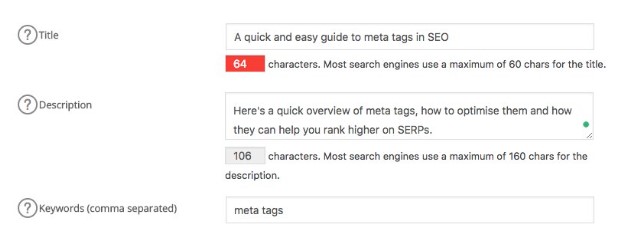Meta Tags for Google SEO: The Ultimate Guideline You Need to Know
The meta tags on your site provide more information about your website to search engines and website users who encounter your website in SERPs. They can be optimized to make your website stand out in search engine results by highlighting its most important elements of it.
While some meta tags have to do with page structure and ensure it’s easy to navigate, others specify which parts of the page are critical and which can be overlooked by search engines.
Meta Tags for SEO: Improve Your Rank on Google
A good user experience is increasingly important to search engines, which means that you should ensure that your website responds to a user’s query as effectively as possible.
Using meta tags, you can ensure that information that searchers need about your page is displayed upfront in an informative and concise manner.
In the SEO world, there are many different types of meta tags that fulfill different roles.
Not every meta tag has a direct effect on SEO. A complete list is available in our guide to meta tags.
To simplify things for you, we have highlighted six of the most important meta tags that you should be aware of for search optimization.
- Title Tag
- Meta Description
- Robots Meta Tag
- Alt Text
- Canonical Tag
- Header Tag (h1, h2, h3, etc.)
In the entire post, you’ll get to know why these meta tags are important for SEO.
So, if you’re someone who wants to rank your website and its content in Google then let’s get started without wasting any time.
1. Title Tag

Users notice the title tag in the SERPs because it is one of the first elements they see. Your page title gives viewers a glimpse of what to expect from your content.
Besides showing up in search results, it also appears as anchor text in social shares and as a title.
Therefore, your title tag should be concise, clear, and not longer than 55 characters.
It is possible to significantly improve SEO if you incorporate a keyword in these 55 characters, but it is even more significant if you add value.
Without being clear, the right keyword in a title won’t necessarily lead to better results.
Title tags are not only for visitors, but they are also for search engines that find your content.
So, you need to blend clarity and context in your title so that it is understandable to everyone.
With a plugin such as Yoast SEO for WordPress, adding your title tag makes it easier to see a preview of your page and how it can appear in search results.
In addition to using a title tag, you can also add it through the website’s HTML, as shown in this example:
<head>
<title>Example Title</title>
</head>
2. Meta Description

It is just as important to include a meta description as a title tag. Title tags are the titles that appear at the top of search engine results and meta descriptions are the snippet that shows beneath them.
Meta descriptions should accurately describe what is on the page you are seeking to optimize.
It is often the factor that determines whether a user will click on your page, so optimizing it is important.
It used to be that meta descriptions should be 150-165 characters long. However, recently, Google has updated the way search results are displayed, which has resulted in longer snippets occasionally appearing.
If you’re interested in learning more about what this means and how SEO can adapt, check out David Portney’s comprehensive article, ‘Google’s updated SERP snippet length: What should be your SEO strategy now?‘.
A meta description can also be added via a plugin like Yoast SEO or you can code it manually in your website’s HTML, as in this example:
<head>
<meta name=”description” content=”Here is a precise description of my awesome webpage.”>
</head>
3. Robots Meta Tag
You should include robots meta tags on your site to tell search engines which pages should be indexed. In a similar fashion to robots.txt, this meta tag is used to prevent search engines from indexing individual pages.
However, robots.txt prevents search engines from indexing a whole site or section of a site.
If you want to tell search engine crawlers not to index a page, or follow any links on it, you would write robots meta:
<meta name=”robots” content=”noindex, nofollow” />
As an alternative, you could replace the robots tag in your code with the following:
<meta name=”robots” content=”index, follow” />
Your robots meta tag should be placed in the head> section of your page, as shown below:
<!DOCTYPE html>
<html><head>
<meta name=”robots” content=”noindex” />
(…)
</head>
<body>(…)</body>
</html>
When you don’t add a robots meta tag, crawlers are likely to index and follow your page automatically.
Is this tag necessary? Possibly, some of your website’s pages are necessary, but lack any substantial content.
Even though you may not want them to appear in search, you can use your noindex tag to keep them out of the SERPs.
Additionally, Google requires nofollow links under certain circumstances. As an example, in 2016, the company instructed bloggers to nofollow any links that they inserted into product reviews, since these links do not come from organic sources.
If you want to stop following an individual link, you can add rel=”nofollow” to the HTML of the link.
On the other hand, if you were simply interested in nofollowing all the links on a particular page, you could use the robots meta tag.
4. Alt Text

Modern SEO considers image optimization to be a vital part of its process since it offers a chance to rank using your visual content in the search results.
Make sure your images are equally accessible to search engines as well as to people.
Alternate text can ensure both: it displays a text alternative to images that will be read out by a screen reader when the image cannot be loaded, and it indicates to search engines what the image represents.
Keywords may be included in your image alt text, but only if it makes sense to do so.
Make sure not to over-stuff this tag with keywords, as it will end up hindering the experience of your users with accessibility needs.
5. Canonical Tag
There may be a need for you to tell search engines which page on your site should be prioritized when you have almost identical pages. Perhaps you’ve syndicated content that’s been published elsewhere on your site too.
However, the use of a canonical tag will prevent you from incurring duplicate content penalties for either of these actions.
In this way, instead of confusing Google and losing your ranking on the SERPs, you are guiding the crawlers to the right URL.
It makes your SEO more effective and prevents cannibalization on the part of others.
In HTML, you could use the canonical tag as follows:
<link rel=”canonical” href=”http://example.com/” />
6. Header Tag (h1, h2, h3, etc.)
A header tag is a part of your content. Shortly put, it’s a heading used to structure your page.
You can also use header tags to help search engines understand what your content is about, in addition to improving user experience and ease of reading.
From h1 to h6, your header tags highlight the importance of each section. Page titles are typically tagged as h1, while article headlines and subheadings are tagged as h2 and below so your content is broken up.
Although header tags are important, you should not use them excessively – focus on quality, not quantity. It doesn’t help your search engine ranking to have five different types of headings on your page.
Rather, make the most of them by strategically breaking up your content and introducing the primary points of each section.
The following is an example of header tags being arranged, taken from the article:
<h1>Meta Tags for Google SEO: The Ultimate Guideline You Need to Know</h1>
<p>Paragraph of content</p>
<p>Another paragraph of content</p>
<h2>Why do meta tags matter?<h2>
<p>Paragraph of content</p>
<h2>Meta Tags for SEO: Improve Your Rank on Google <h2>
<h3>1. Title tag</h3>
H1 should usually be used only once, while h2 and h3 can be used in more than one row.
Optimize Your Meta Tags for SEO: A Proper Checklist to Follow
Well, search engines and searchers can both benefit from meta tags. By using them in a proper way, users’ experience can be improved, as well as business information displayed effectively.
Consequently, this can lead to increased authority, enhanced search visibility, and hence, a higher ranking to SERPs.
Below is a quick checklist to help you start your evaluation of your meta tags:
- Verify that your content and all your pages have title tags and meta descriptions with the right keywords.
- Improve how you structure your content by paying attention to headings and subheadings.
- Remember to add alt text to images.
- Include meta tags to tell search engines what to index.
- Don’t cannibalize your own content by creating duplicate content. Look for duplicate pages and use canonical tagging to avoid doing so.
- Turn meta tags into a part of your routine when you are creating new content, and create a checklist of the steps you need to include.
Wrapping Up: Why Meta Tags Are Important for Your SEO
Your page’s meta tags (Title tag, Meta description) are the first thing people see when searching on a search engine. Properly utilizing meta tags will encourage users to click through and visit your website.
To be more specific, search engines will be able to identify the content on your website through the right meta tags, which will then show up in the appropriate search results. Don’t forget that less is more sometimes.
Ideally, meta tags should have an excerpt that gets straight to the point and provides the most pertinent and important information. Using these tags will drive the most click-throughs.
Remember that meta tags are extensions of your ad text, so ensure that it is appealing, inviting, and concise while still being catchy, inviting, and thoughtful.






